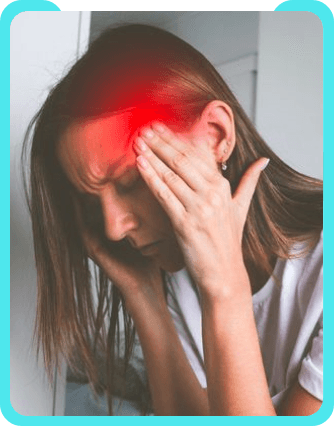
Pain at the Back of the Head
- Home
- Pain at the Back of the Head
A headache can range from mild to severe pain. It can cause as the main reason, but symptoms are needed to be understood. Many of the headaches that are caused can be stiffness or tightness in the neck that can lead to pain at the back of the head. The symptoms can relate to different conditions that cause headaches. However, there are underlying symptoms that cause back head pain.
Types of Headaches
Tension Headache
Most people suffer headaches due to stress and tension, which is a common scenario in today’s time. It usually starts at the forehead, and pain at the back of the head is also the most common cause. The pain can be brief, but it can last up to 1 week as well.
Symptoms
- Tension type headache symptoms may include one or more of these patterns:
- feeling stiffness or tightness at the back or front of the head
- pain can be mild, moderate, or severe (rarely)
- tension headache can also occur due to fatigue, hunger, or without an underlying cause
Treatment
Treatment is usually prescribed with over-the-counter medications by experienced doctors. The pain will be relieved from a tension headache.
Migraine Headache
A migraine headache is another condition that can be extremely painful, throbbing pain on one side of the face and head. People with migraines are likely to experience pain in the back of the head. It can be a chronic pain condition. The migraine headache can occur several times and can last from few hours to several days.
Symptoms
The symptoms of migraine headaches vary from person to person. The most common signs of migraine headache are
- a severe pain
- throbbing or pulsing on one side or multiple sides of the head
- nausea and vomiting
- a migraine headache can cause sensitivity to light and sound
- visually disturbance
Treatment
Over-the-counter medications help to relieve pain from the headache. However, patients experiencing frequent migraines may benefit from beta-blockers to minimize the frequency and severity of the headaches.
Trigeminal Neuralgia Headache
Trigeminal neuralgia is chronic pain, occurs spontaneously and affects the trigeminal nerve, a nerve responsible for the sensation from the face to the head. Usually, trigeminal neuralgia headache starts with mild pain, but it progresses, and it causes frequent bouts of intense pain. It is most likely to occur in women than men and people above 50.
Symptoms
Trigeminal neuralgia headache may include one or more of the following symptoms
- episodes of searing, shooting, or jabbing pain, one may feel like an electric shock
- frequent episodes of cluster attacks, which can be even longer
- A spontaneous attack of pain that triggers on the face, brushing teeth, chewing, or even speaking
- pain lasting from few seconds to several minutes
- trigeminal neuralgia headache can last for days, weeks, months, or more
- pain on one side of the face, or may occur on both sides
- tingling or numbness appear on the face before starting the pain
- pain is focused only on one spot, or it may even spread in a wider pattern
- some people may experience attacks of pain, and it may become more frequent
Treatment
Treatment for trigeminal neuralgia usually starts with medications. Most of the patients are cured by prescribed medications. Additional treatments are available for those who failed to respond to the medication. Injections and surgery are the other treatment options available for the patients.
Consultation
Diagnosis
Get a diagnosis from highly qualified doctors to get an overall examination, the root cause of the headache, and to determine the best available treatment that helps to relieve your pain.




